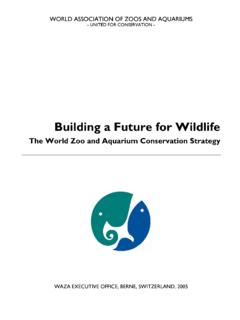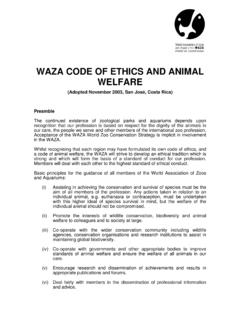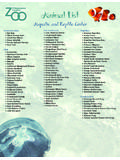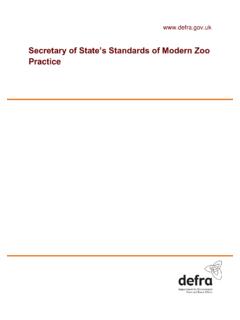Transcription of Future of Zoo and Aquarium Design - World Association of ...
1 Future of Zoo and Aquarium : 2074-4528 ContentsSusan A. Chin1 & Markus Gusset2 Editorial Editorial ..1 Susan A. Chin & Markus Gusset Zoo and Aquarium Design Yesterday, Today and (the Day after) Tomorrow ..3 Peter Rasbach Advocacy Through Thematic Design ..8 L. Azeo Torre Showcasing Science and Research ..12 Charles G. Mayes & Ed Mastro Zoo and Aquarium Design The impact of Experience ..16 Kieran Stanley Designing Zoos and Aquariums as Conservation Organisations ..20 John Kemper Designing for Active Animals ..24 Greg Dykstra Wellness-inspired Design for Elephants ..28 J lia Hanuliakov Land of Lions at ZSL London Zoo ..32 Ray Hole Woodland Park Zoo s Banyan Wilds: Conservation and Connection with Asia s Malayan Tigers and Sloth Bears.
2 36 Becca Hanson & Monica Lake A Playground in Nature: Longsha Zoological and Botanical Garden in China ..40 Patrick Janikowski, James Brighton, Joyce Lee & Terry O Connor ZooLex by the Numbers ..45 Monika FibyWe are pleased to bring you the first WAZA Magazine dedicated to exhibit Design at zoos and aquariums. Why would we focus on Design when there are so many pressing issues facing zoos and aquariums? Simply put, Design is a critical tool that can shape our animals well-being and our visi-tors experiences. It determines how we tell our stories and creates the primary physical interface with our visitors. It influences the efficiency and effectiveness of our facilities and significantly impacts animal care and welfare.
3 Zoo and Aquarium Design should not be simply about creat-ing novel ways to house and view animals; it has to serve a greater pur-pose, one that engages our visitors in our conservation and animal welfare the past few decades, the com-plex and unique considerations that go into designing zoos and aquariums has led to the emergence of a highly skilled and motivated cadre of zoo-logical Design specialists. The articles that follow examine questions around the Future of zoo and Aquarium de-sign from the perspective of some of the leading practitioners in the field, all of them members of or affiliated with for zoos and aquariums involves much more than enclosure Design . In addition to animal exhibit spaces, it is vital to consider behind-the-scenes management and support areas, associated public spaces and tactical approaches to story-telling, including high- or low-tech interpre-tive media.
4 As we think about the Future of zoo and Aquarium Design , it is important to consider the advances of the past and to pose key questions about the directions in which our institutions may is our mission? Each zoo or Aquarium will have a specific mission relevant to their organisation and cultural context, but today most are (or will be) defining themselves in the broader context of supporting conservation. Holistic integration of our conservation mission from animal exhibits, to merchandise in the gift shop, to marketing is essential. We need to be engines for conservation funding, innovators of research and science that support conservation, stewards and propagators of insur-ance populations and perhaps most critically places that facilitate conservation awareness and action for our millions of are our audiences and what do they want?
5 This will differ depending on location and history. Understand-ing not just sociological and demo-graphic composition of our audiences, but knowing more about visitors expectations will give us a framework for designing meaningful and engag-ing visitor do we stay relevant? Under-standing why we are or are not relevant to different audiences can help us Design exhibits to reach a broader audience. Increasing our visi-tors understanding of the important conservation and science work done at zoos and aquariums can help cre-ate relevant connections. Also, as zoos and aquariums are increasingly involved in local conservation pro-jects, we are positioned as a source of environmental information and opportunities for do we define and Design our visi-tor experience?
6 Our unique and defin-ing element is living animals. How do we facilitate and interpret staring into the eyes of another species; contact with another sentient being? How do we use this to best effect? In many places, zoos and aquariums are an antidote to urbanity; a place to connect with nature and escape daily life. People have always come to zoos and aquariums to make memories and we facilitate this important social bonding are the most impactful and ap-propriate Design strategies? Land-scape immersion can be an effective strategy in some situations, but it is not necessarily appropriate every-where. How do we use all of the tools in our toolkit to engage our visitors? Graphics, interactives, technology, events, programmes, live interpreta-tion can all play an important role in achieving our goals and they all have Design can we support our mission with Design ?
7 Opportunities for new revenue streams can be thematically integrated into master plans and new exhibits to support financial : Markus Gusset & Susan A. Chin WAZA Executive Office IUCN Conservation Centre Rue Mauverney 28 CH-1196 Gland Switzerland Phone: +41 22 999 07 90 Fax: +41 22 999 07 91 Layout and typesetting: Cover: Roy Lewis/Detroit Zoo & J lia Hanuliakov /Zoo Design Inc. Print: Agentura NP, Star M sto, Czech RepublicEdition: 600 copies | WAZA 2016 This edition of WAZA Magazine is also available on on FSC WCS Vice President of Planning & Design and Chief Architect2 WAZA Chief Conservation Officer Julie Larsen Maher/WCSWAZAWAZA17 (2016)17 (2016)23 SummaryThis article provides numerous examples of exhibits throughout the recent history of zoo Design .
8 These examples range from the invention of immersing exhibits and their global spread, to exemplary exhibits where size matters, to important Design considerations. The development of zoos and zoo Design runs in parallel with one another. Zoos and Aquariums Are not for Animals, They Are for People This criticism, which is often raised by zoo opponents, is increasingly also being shared by zoo experts. Never-theless, or specifically as a confirma-tion of this, over 700 million people a year visit one of the more than 1,000 organised zoos worldwide, with the trend rising in line with a growing human population and the associated alienation from nature. With this, a continuing negative process from the 1980s and 1990s is being reversed, in which the question regarding the purpose of such facilities is concern-ing the public with unprecedented clarity and radicalism.
9 Permanently and increasingly in recent times, society is dealing with the contro-versial question of the right to keep exotic animals in captivity and exhibit them. In addition to the basic question of ethics, size, safety and particularly Design are being critically task must zoo Design perform in this area of conflict? The large city zoos that were created after the French Revolution in Vienna, Paris, London and other locations, show exotic animals in ethnographically orientated, stylised structures with small iron cages and generously sized visitor areas. In addition to purely satisfying curiosity, with the establishment of zoological societies in London, Frankfurt and New York, the seeds are sown for interest in the morphology of animals and initial serious research in the mid-19th century.
10 Botanical and zoological gardens evolve in parallel, with few 1907, in his zoo in Hamburg-Stel-lingen, Carl Hagenbeck presents the innovation of animals in open enclo-sures, in spacious, replica panoramas, thereby sustainably revolutionising zoo architecture. In spite of these be-ginnings, after the end of World War II, a long period begins during which animal enclosures are planned and built according to hygiene considera-tions and with the aim of breeding successes being as comprehensive as possible. Concrete, tiles, glass and stainless steel, all products of the hu-man environment, widely determine the zoo structures of those collections of zoos continue to be supplemented from the wild. In spite of increasing knowledge about the medical and behavioural require-ments of the animals, these circum-stances continue into the 1980s.










